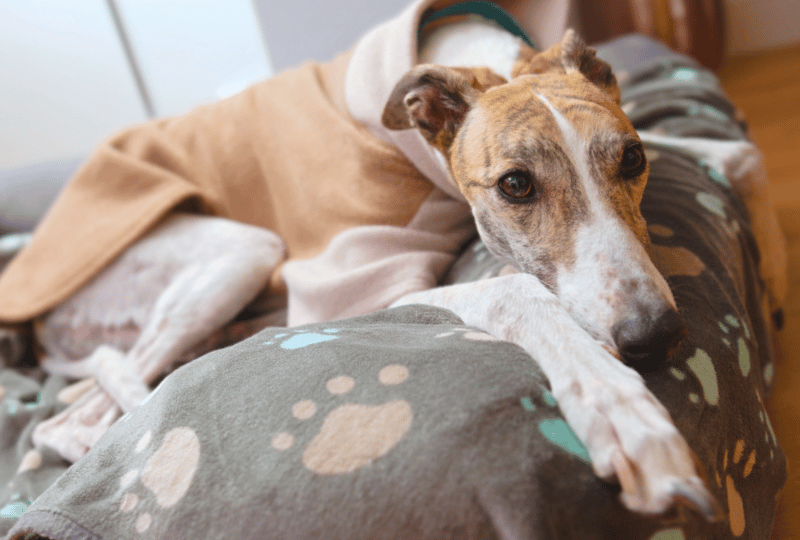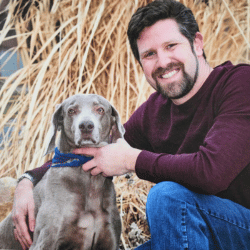Pet parents often take notice when their dogs choose strange or unusual places to sit. Whether it’s trying to climb into your lap in the car or taking a snooze on your chest while you try to sleep, it’s worth exploring what motivates our pups to sit, lay, and sleep where they do!
We recently had a Not A Bully reader ask:
“My dog Zozo is always behind me! If I’m in the kitchen cooking, he’s sitting down right behind (which makes meal prep a lot more difficult). If I’m on the couch, he’ll try to squeeze in behind me but he’s a 60-pound retired greyhound! What’s going on here and how can I teach Zozo to find another spot? Thanks in advance!”
I discussed this question with two of Not A Bully’s advising veterinarians, Dr. Menicucci and Dr. Patel, and here’s what we came up with:
Dogs sitting or lying behind their owners often signal a strong bond with their owner but preference, comfort, and anxiety can all also be motivations. Protective instincts can contribute, particularly in breeds with guarding backgrounds.
You could also be encouraging the behavior, without even realizing it, especially if your dog is trying to squeeze themselves into strange or funny places that get a reaction from you. Your reaction and attention could be positively reinforcing the behavior.
If the behavior stems from insecurity or becomes inconvenient, redirecting your dog to a designated spot by using positive reinforcement can help. You can also teach your dog the “Place” command to help communicate to them when it’s time to lay down in their bed or crate.
That’s the quick answer, but we’ll take a look at all the possible reasons to help you understand which explanation makes sense for your dog. Let’s get started!
Reason 1: You Have A Strong Bond
Unless you’re seeing anxious body language (like a tucked tail, lowered head, flattened ears, or stiff posture), your dog is likely just happy to be near you, and sitting or lying behind you is a great way to stay close to their favorite person. Dr. Menicucci explains “This behavior can often be a sign of a strong bond and deep trust between the dog and the owner.”
As with any aspect of canine behavior, we need to make sure we’re paying attention to body language. If your dog appears calm and relaxed while they’re behind you, then they’re probably just trying to stay close. However, if you’re seeing panting, tense postures, or signs of stress, you could be looking at anxiety or stress response as the primary motivation.
Reason 2: Your Pup Could Be Anxious
Feeling a sense of safety and comfort when sitting behind you, or sitting between your legs, especially if there are strangers present is not unusual. Dr. Menicucci further explains that “Shy or anxious dogs might also seek out these ‘safe’ spots (like sitting behind you) due to past negative experiences or lack of socialization.”
Again, context is important to figuring out which explanation makes the most sense for your dog. Triggers like visits from other pets, guests, thunderstorms, or any stressful situations could lead to your pup snuggling behind you to feel safe and hidden.
Look for signs of anxiety to confirm this explanation. This video does a great job explaining and showcasing the body language of an anxious dog:
Reason 3: They’re Being Protective
While sitting behind you might not be the most advantageous position for a dog to protect you, depending on the situation, it could give them a clear view of what’s going around them. If you’re chopping up veggies at the kitchen counter, lying down behind you could be the perfect spot for their self-appointed protection work.
Before dogs became our best friends, they served as herders and guardians of sheep, goats, cattle, and humans. These protection instincts are still quite ingrained, especially in guard dog breeds like the Rottweiler, Boxers, and probably the most well-known breed the German Shepherd.
Of course, you don’t have to own one of these breeds to have a protective pup and Dr. Menicucci explains that “while some breeds may have a heightened protective instinct, individual personality can also play a significant role.”
Dogs may show clear body language that they’re guarding (like wide eyes, alert ears, and tense postures) but others may just sit relaxed and choose to sit behind you because it’s a good vantage point. We see similar behavior in dogs that prefer to post up by the door.
It might be flattering to have your dog protect you, but Dr. Menicucci points out that “it’s important to monitor this behavior to ensure it doesn’t develop into overprotectiveness or possessiveness.”
Reason 4: It’s Simply Their Preference
In some cases, the explanation isn’t any more complex than your dog simply likes the spot behind you. Dogs can create habits and they can get attached to people, specific toys, and even a room in your home so it’s not surprising that they can also claim a spot on your couch or armchair.
If your dog is part of a big family, then they might also not have enough space to snuggle on the couch, and sitting behind you is the best they can hope for. They might enjoy your body heat or want to share your warm blanket along with any number of other factors that could make the space behind you preferable for your pup.
This habit isn’t necessarily harmful as long as your dog isn’t overly possessive and becomes agitated or aggressive when other pets approach the spot or try to sit behind you. Dr. Menicucci adds that “while dogs can have favorite spots, owners need to set boundaries if this behavior becomes problematic, such as blocking access or redirecting the dog to a designated spot. Try offering a warm bed or blanket in a preferred spot for the dog to encourage them to sit there instead.”
Reason 5: You Could Be Encouraging The Behavior
The initial reason your dog curled up behind you while you were watching TV could have been a thunderstorm, or their need to be close to you when they were a puppy. But if they were never told that they’re not allowed to sit there then they won’t give up their comfy seat behind you.
I’ve also seen many situations where a dog takes on a strange behavior that the owner found funny which resulted in extra attention for the dog. That extra attention positively reinforced the behavior- even if the owner didn’t realize or intend it.
It’s also possible that this is more of an attention-seeking behavior. Your dog knows that they’ll be moved away from that spot but they keep going there because that’s how they get your attention. If every time you move them you start cuddling them, or you give them a toy to play with then it’s only natural and logical that they’ll keep practicing this method.
Reason 6: They’re Not Feeling Well
As with most dog behaviors noticing your pup suddenly acting weird is worth investigating.
If your canine companion has never shown any desire to sit behind you before and now they try to squeeze between you and your chair, then this could be a sign of illness.
Whether they’re injured or in pain, they may try to seek comfort and safety behind you.
With sudden shifts in behavior like this one the best thing you can do is take your pooch to the veterinarian but also observe other possible signs of sickness like a change in their appetite, energy levels, vomiting, or diarrhea.
Should I Be Worried If My Dog Is Sitting Behind Me?
Whether this is a behavior that needs to be stopped or not is your decision to make.
The explanation behind this behavior could also affect this decision. If it’s the result of their separation anxiety, a lack of confidence, or possessive aggression over a spot then these are all reasons enough to stop it and help your dog find better coping methods.
When your dog is sitting behind you without getting in the way while you’re busy in the kitchen or you’re working at your desk then it should be fine, but if they sit behind you when you’re sitting then it can be dangerous, especially when it comes to small breeds or puppies.
What Can You Do If Your Dog Is Sitting Behind You?
If you sense that this behavior stems from your dog’s insecurities or it’s simply becoming an irritating habit, then you need to make a few changes.
Redirect The Behavior
Create a cozy area where your dog can feel safe, comfortable, and happy while staying near you.
An alternative spot could be on the couch next to you instead of behind you or a nice dog bed with a warm blanket placed by your couch or working desk. This way your dog will have their own sitting area and with some encouragement, they won’t have to sit behind you anymore. You can use treats or praise to positively reinforce your dog’s behavior when they choose their designated spot overlying or sitting behind you.
You can also use a crate as their designated spot. A crate acts as a den or safe space for your dog. With the right training, your dog will want to spend time in their crate. Crates should never be used for punishment, and that’s not what we’re doing here. Instead, we’re letting our dogs know that the crate is their safe spot.
Teach Your Dog Their Spot With The “Place” Command
You can take things further by teaching “place” as a trained command for your dog.
Whether that’s a crate or a dog bed, this is particularly helpful for dogs that are overly anxious or struggle with impulse control.
“Place” is an incredibly useful command especially for clingy dogs, as it can be used when you are cooking in the kitchen or when someone rings the doorbell. Also, spending time training a new command is a rewarding experience for both you and your dog and will help to build trust and confidence.
Closing Thoughts
It might be cute at first but having a 60-pound greyhound trying to squeeze in the little space behind you can get old…fast! Whatever the motivation, redirection and positive reinforcement will typically help your dog understand the better spot for them to find safety and comfort.
If you’re struggling to change your pup’s behavior, hiring a trainer can help. We always recommend working with a Certified Professional Dog Trainer and you can find a directory of them here. If you’re in the Colorado Springs area, you can work directly with Not A Bully Dog Training.
What do you think? Feel free to comment questions below or share the story of your pup!



